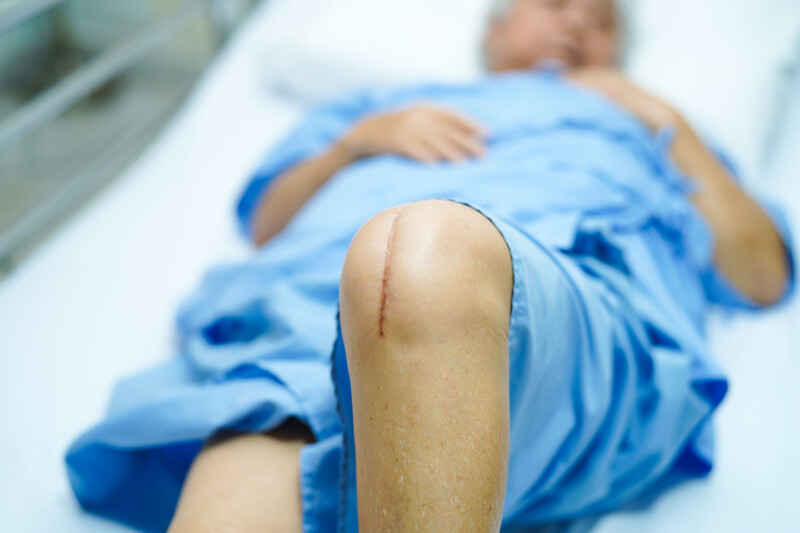There are a lot of people waiting for surgery these days. Many of these people maybe waiting for a surgery they do not need. While they wait for this surgery that they may not need, they may be taking more painkillers and getting more cortisone injections. Treatments that did not help them initially but because of the extended wait for surgery, they are back on them and in some cases stronger doses.
Researchers are advising doctors that they must carefully examine and look for hip joint deterioration before giving a recommendation for back and knee surgery. Why? Doctors may be performing unnecessary and unneeded knee and back surgery. Who says so? The surgeons themselves.
Unnecessary and Unneeded Surgery
What is a definition of an unnecessary or unneeded surgery? Recently, in a study in the American Association of Hip and Knee Surgeons’ journal Arthroplasty today (1) revealed that patients could be getting an unnecessary and unneeded knee surgery. How? A misdiagnosed hip problem referring pain to the knee. This is from the study: Referred pain from the hip to the knee can be misleading to healthcare providers including musculoskeletal providers. . . (this study) highlights the following warning signs that should prompt investigation of the hip as a potential underlying source of knee pain:
knee pain out of proportion to clinical and radiographic findings related to the knee;
significant disability and use of walking aids, especially a wheelchair or walker;
abnormal hip motion during physical examination and knee pain that fails to improve with knee interventions.
This constellation of findings should raise the index of suspicion to evaluate extrinsic sources for knee pain, especially the hip. Improved awareness of this issue may more quickly lead to an accurate diagnosis, timely treatment of the source of pain, and prevent unnecessary interventions for affected patients.
A vulnerable group – women over 50
Another recent study investigated the factors associated with the level of knee pain in women aged 50 years or older. The study published in the journal Public Library of Science (2) found that women over 50 with knee pain, without clear knee osteoarthritis on MRI, should be examined for problems of weight or body mass index, level of hip pain and presence of low back pain, before surgical recommendation is given and acted upon.
The problem of diagnosing the wrong joint for surgery is not a new phenomena
The hip is a tricky joint. It can make patients and doctors think that the pain the hip is generating is localized to other joints and areas of the body.
A 2013 study published in the medical journal Modern Rheumatology, (3) discussed the complexity of hip pain and its far-reaching influence into other areas of the body.
In this study, distribution of pain originating in the hip was:
89 % of patients had groin pain that could be misinterpreted
38% of patients had buttock pain that could be misinterpreted
33% of patients had pain in front of thigh buttock pain that could be misinterpreted
29% of patients had knee pain that could be misinterpreted
27% of patients had greater trochanter pain that could be misinterpreted
17% of patients had low back pain that could be misinterpreted
and 8% of patients had lower leg pain that could be misinterpreted.
Misinterpretation in the studies cited in this article, leads to the wrong surgery. The possibilities for surgical error, performing surgery on what is not causing pain, is significant.
A March 2018 study (4) expanded on this research by saying that before you send women to surgeries they may not need you must explore weight and depression, two controllable factors that will make a woman’s knee pain worse.:
“Women without knee osteoarthritis tended to report increasing knee pain with increasing age. Body Mass Index is considered a significant controllable factor in knee pain in women regardless of the presence of radiographic knee osteoarthritis. The presence of depressive symptoms may aggravate knee pain in women with knee osteoarthritis. Attention needs to be focused on concomitant musculoskeletal problems such as lumbar spinal and hip diseases in women with knee pain.”
Pain after knee replacement? Maybe your knee did not need to be replaced
Here is another interesting study out of the United Kingdom. Writing in the medical journal, International Orthopaedics, (4) researchers sought to explain why “up to 20% (of total knee replacement patients) complain of persisting pain.”
At Lister General Hospital in the United Kingdom, doctors looked at 45 consecutive patients with painful total knee replacement. Of the 45 patients, one-third, had degenerative hip and lumbar spine disease and 9 patients had unexplained pain.
The doctors concluded: “Patients may still be undergoing knee arthroplasty for degenerative lumbar spine and hip osteoarthritis. We suggest heightened awareness at pre- and post-operative assessment and thorough history and examination with the use of diagnostic injections to identify the cause of pain if there is doubt.”
Knee pain persisted after knee replacement because the problem was not the knee, but the hip and spine.
In a 2017 study published in the journal Clinical Orthopedic Surgery, (5) doctors made this remarkable discovery:
In patients with pain after knee replacement, where problems in the replaced knee were ruled out,
25.6% of patients in the study were found to have nerve entrapment in the spine
15.4% were found to have hip osteoarthritis or femoral head avascular necrosis
and knee pain persisted after knee replacement because the problem was not the knee, but the hip and spine.
Understanding Referred Pain
One of the most remarkable aspects of regenerative medicine injections is the physical examination by an experienced physician. Joints and other areas of the body are given a detailed examination looking for those spots that generate pain triggers. Gently pressing on a suspect knee may elicit a pain reaction in the hip. A gentle pressing in the hip may elicit a pain reaction in the groin and knee. It is very rare that we see a joint problem in complete isolation, meaning it is not impacted by or impacting other joints.
Before surgery, please consider an appointment at the Magaziner Center for Wellness to help make sure the true source of your pain is identified. Why have surgery if surgery is not actually needed?
Related Articles:
Why Are Post-Menopausal Women Prone to Falls?
Why Are Post-Menopausal Women Prone to Falls?
Researchers Say Knee Osteoarthritis Patients Need Vitamin D
https://drmagaziner.com/knee-pain/stem-cell-treatments-for-bone-on-bone-knees/
Researchers Say Knee Osteoarthritis Patients Need Vitamin D
Options For Partial Knee Replacement
References:
1. Dibra, F. F., Prieto, H. A., Gray, C. F., & Parvataneni, H. K. (2017). Don’t forget the hip! Hip arthritis masquerading as knee pain. Arthroplasty today, 4(1), 118-124. doi:10.1016/j.artd.2017.06.008
2 Lee KM, Kang SB, Chung CY, Park MS, Kang DW, Chang CB. Factors associated with knee pain in 5148 women aged 50 years and older: A population-based study. PLoS One. 2018;13(3):e0192478. Published 2018 Mar 8. doi:10.1371/journal.pone.
3. Nakamura J, Oinuma K, Ohtori S, et al. Distribution of hip pain in osteoarthritis patients secondary to developmental dysplasia of the hip. Mod Rheumatol. 2012 Apr 11
4 Lee KM, Kang SB, Chung CY, Park MS, Kang DW, Chang CB. Factors associated with knee pain in 5148 women aged 50 years and older: A population-based study. PLoS One. 2018;13(3):e0192478. Published 2018 Mar 8. doi:10.1371/journal.pone.0192478
5. Al-Hadithy N, Rozati H, Sewell MD, Dodds AL, Brooks P, Chatoo M. Causes of a painful total knee arthroplasty. Are patients still receiving total knee arthroplasty for extrinsic pathologies? Int Orthop. 2012 Jan 11. [Epub ahead of print]
6. Lim, H.-A., Song, E.-K., Seon, J.-K., Park, K.-S., Shin, Y.-J., & Yang, H.-Y. (2017). Causes of Aseptic Persistent Pain after Total Knee Arthroplasty. Clinics in Orthopedic Surgery, 9(1), 50–56. http://doi.org/10.4055/cios.





































Recent Comments